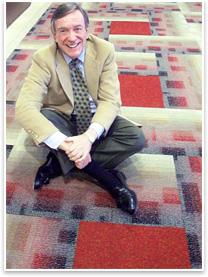
| Ray Anderson
Profession: Founder, CEO, and chair of Interface. Education: Bachelor’s degree in industrial engineering from Georgia Tech. First job: I worked for Proctor and Gamble for two and a half years in manufacturing. Hobbies: Well, I love my Georgia Tech football and basketball. Aside from that, I guess reading is my hobby. Favorite place to getaway: I have a house in the mountains off the grid, which is great fun for relaxing in a serene setting. It’s in a little community called Scaly in the Blue Ridge Mountains of North Carolina. Favorite book: One that’s most meaningful to me is Paul Hawken’s book The Ecology of Commerce, but I guess I could name a hundred books in that general category that I’ve read and all were meaningful to me. Why you’re making Interface green: Reading The Ecology of Commerce was an epiphany. I read it to gain some inspiration for a speech I had been asked to give to a new environmental task force in our company. I was asked to launch the new task force with my environmental vision, but I didn’t have an environmental vision, so I didn’t want to make the speech. I was looking for inspiration, and that book landed on my desk by pure serendipity. Without having any idea of what was in it, I began to read it, and about page 19, it hit me like a spear in the chest. Consequently, I made that speech, which put our company on its present path toward sustainability. Hawken made the central point of his book in three parts. One was that the living systems and the life support systems that compose the biosphere are all in decline, and it’s a global systemic problem and a looming crisis. Second, he says that the biggest culprit is the industrial system and its linear system of taking from the Earth to make a product with very little lasting value that ends up as waste in the landfill. That linear take/make/waste system, driven by fossil fuels incidentally and very abusive to the biosphere, he says is the major culprit. Well, that’s what I do. The third part of his central thesis is there’s only one institution on Earth that is large enough, powerful enough, pervasive enough, influential enough, and wealthy enough to really change that course for humankind and that is the same institution that’s doing the greatest damage: the institution of business and industry. All of that resonated with me. At the time I was 60 years old and undoubtedly a sense of legacy was lurking somewhere in my subconscious. This is a company I had founded 21 years before, and I’m sure I was asking in a subconscious way, “What’s this child of mine going to grow up to be?” Hawken’s book gave me that vision of a sustainable industrial, even restorative, enterprise: putting back more than we take from Earth and doing good for Earth, not just doing no harm. Most rewarding aspect of your job: Creating something that never existed before. We’ve done it twice now. First, with the carpet tiles, we created a very successful company out of an idea. Now, we’re recreating that company to be a sustainable or restorative company, and that’s basically out of an idea, too. Neither of those really existed in a successful form. Greatest challenge in becoming sustainable: Well, two things. First, the technologies didn’t exist when we began, or they were in very early stage and very expensive, so we’ve almost had to invent our way. The second is keeping people focused year after year after year and not letting it become the program of the week, month, or year, but the program of a lifetime: keeping our eyes on the prize, as they say. But, the biggest challenge is in the technological area. If you want to create a company that has no impact on the Earth, you have to run it with solar energy, not fossil fuels, and you have to create recycling processes that get back all your product and use it all in its second life. And you do it all without abusing the biosphere and without being wasteful—zero waste, zero impact. We actually call it Mission Zero, that’s where we want to be: absolutely no impact on the environment. The target year for that is 2020. We started 12 years ago and we still have 14 years to go. We’re about 40 percent of the way, maybe a little bit more, so we’re basically on track to reach that idealized goal. Advice for young professionals: Study biology. Advice for architects: Study biology. Ecological ignorance abounds in our society. Hawken says an average American can probably name 1,000 commercial brands and maybe 10 trees, which I think is probably not far off. We do not appreciate our connection to the web of life. We take the whole thing for granted and it’s as old as Jack and the Beanstalk and The Goose that Laid the Golden Egg. Nature is that goose. If we squeeze nature until she dies, there are no more golden eggs; no more eggs of any kind if you follow the analogy. It’s very poorly understood that the under-girding infrastructure of civilization itself is the natural world. It’s nature that supplies air, water, food, energy, and materials. It keeps the ultraviolet radiation from killing us all, regulates the climate, recycles nutrients, controls floods, and creates water distribution and purification through the hydrologic cycles. Without any of those, you have no economy and you have no livable civilization. The next big step for Interface: Lots of little steps, leading towards the top of Mount Sustainability. |
||
Copyright 2006 The American Institute of Architects. All rights reserved. Home Page |
||
news headlines
practice
business
design

